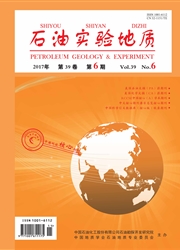

 中文摘要:
中文摘要:
对安徽巢湖平顶山西坡剖面下三叠统殷坑组瘤状灰岩中瘤体与基质的矿物组成、结构、构造、化学成分及地球化学等进行了系统研究。结果表明:瘤状灰岩在殷坑组极其发育,由瘤体和基质两部分组成;瘤体主要多为灰色、浅灰色或灰白色微晶灰岩、泥晶微晶灰岩和微晶泥晶灰岩,主要矿物是方解石,占整个瘤体的54%~85%,次为石英、斜长石和黏土矿物等陆源物质,还含少量的黄铁矿;基质颜色较深,以黄色、褐黄色和黄灰色钙质泥岩为主,泥质微晶灰岩次之,与瘤体相比,基质中方解石矿物明显减少,石英、黏土矿物明显增加,斜长石含量变化不大;按瘤体的排列方式将瘤状灰岩划分为断续状、条带状和杂乱状3种类型,其是后期差异性压实与压溶作用逐渐增强的结果;剖面中断续状瘤状灰岩最先出现,而且出现的层位多,厚度大,主要发育在上斜坡环境,仅少量出现在下斜坡,然后为条带状瘤状灰岩,分布在下斜坡,杂乱状瘤状灰岩出现的层位最少,厚度最小,最不发育,仅分布在深水盆地环境。
 英文摘要:
英文摘要:
The mineral composition, structure, chemical composition and geochemistry characteristics of nodules and matrix from Lower Triassic Yinkeng Formation at West Pingdingshan section in Chaohu of Anhui,China were systematically studied.The results show that nodular limestones are composed of nodules and matrix,and develop well in Yinkeng Formation;nodules are mainly composed of microcrystalline limestone,micritic micrite and microcrystalline micrite calcite with the color dominated by gray,light gray and gray white;the main minerals of nodules are mainly calcite,accounts for 54%-85%,the rest part is made up of quartz,plagioclase and clay minerals,and also contain a small amount of pyrite;the matrix occurs predominantly of yellow,brown-yellow and yellow-gray calcareous mudstones,followedwith pelmicrite;compared to nodules,matrix contains less calcite mineral,more quartz and clay minerals;there are three types of the nodular limestone,including banded nodular limestone,discontinuous nodular limestone and random nodular limestone;the three types are the result of combined processes of the differential compaction,and gradually enhance pressure solution during the diagenesis;discontinuous nodular limestone occurs first within many layers and thicker,and develops mainly in the upper part of slope;then,banded nodular limestone distributes in the lower part of slope;at last,random nodular limestone is thinner and develops poor,only appears in deep water basin environment.
 同期刊论文项目
同期刊论文项目
 同项目期刊论文
同项目期刊论文
 期刊信息
期刊信息
